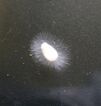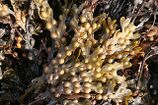Biology:Gyrista
| Gyrista | |
|---|---|
| Gyristan representatives (clockwise from top-left): water mould, brown algae, diatoms, Develorapax. | |
| Scientific classification | |
| Domain: | Eukaryota |
| Clade: | Diaphoretickes |
| Clade: | TSAR |
| Clade: | SAR |
| Clade: | Stramenopiles |
| Phylum: | Gyrista Cavalier-Smith 1998[1] |
| Classes[2] | |
| |
Gyrista is a phylum of heterokont protists containing three diverse groups: the mostly photosynthetic Ochrophyta, the parasitic Pseudofungi, and the recently described group of nanoflagellates known as Bigyromonada.[2] Members of this phylum are characterized by the presence of a helix or a double helix/ring system in the ciliary transition region.[1]
Phylogeny
Gyrista was seen in 2017 as the sister group to phylum Bigyra, which contains the Sagenista and Opalozoa. Together, Gyrista and Bigyra form the superphylum Stramenopiles or Heterokonta.[2][3]
| Stramenopiles |
| |||||||||||||||||||||||||||||||||
A phylogenetic analysis in 2022 recovered a monophyletic Bigyromonada sister to Pseudofungi. The "Bigyra" is paraphyletic:[4]
| Stramenopiles |
| ||||||||||||||||||||||||||||||
Classification
The 2018 revised taxonomy of Gyrista is the following,[2] with the inclusion of new ochrophyte classes described in 2020[5] and 2021:[6]
- Subphylum Bigyromonada Cavalier-Smith 1998
- Class Developea Aleoshin et al. ex Cavalier-Smith 2017 [=Bigyromonadea Cavalier-Smith 1997]
- Class Pirsonea Cavalier-Smith 2017[2]
- Subphylum Pseudofungi Cavalier-Smith 1986 [=Heterokontimycotina M.W. Dick 1976]
- Class Hyphochytrea Cavalier-Smith 1986 [=Hyphochytriomycota Whittaker 1969]
- Class Oomycetes Winter in Rabenhorst 1879 [=Oomycota Arx 1967; Peronosporomycetes M.W. Dick 2001]
- Subphylum Ochrophytina Cavalier-Smith 1995 [=Heterokontophyta van den Hoek et al. 1978; Stramenochromes Leipe et al. 1994]
- Infraphylum Chrysista Cavalier-Smith 1991
- Superclass Limnistia Cavalier-Smith 1996 emend. 2006
- Class Eustigmatophyceae Hibberd & Leedale (1971)
- Class Chrysomonadea Saville-Kent 1881 stat. nov. Pascher 1910 emend. Cavalier-Smith 2017 [=Chrysophyceae Pascher 1914]
- Class Picophagea Cavalier-Smith 2006 emend. 2017 [=Synchromophyceae Horn et al. 2007]
- Superclass Raphidoistia Cavalier-Smith 1986 orth. mut. 2006
- Class Raphidomonadea Chadefaud ex Silva 1980
- Subclass Raphidophycidae Cavalier-Smith 2013
- Subclass Raphopoda Cavalier-Smith 2013
- Class Raphidomonadea Chadefaud ex Silva 1980
- Superclass Fucistia Cavalier-Smith 1995
- Class Aurophyceae Cavalier-Smith 2013
- Subclass Aurearenophycidae Kai Yoshii Nakayama & Inouye 2008 (as Aurearenophyceae)[7] stat. nov. Cavalier-Smith 2013[8]
- Subclass Phaeothamniophycidae Andersen & Bailey 1998 (as Phaeothamniophyceae) stat. nov. Cavalier-Smith 2006
- Class Chrysomerophyceae Cavalier-Smith 1995
- Class Chrysoparadoxophyceae Wetherbee et al. 2019
- Class Phaeosacciophyceae R.A.Andersen L.Graf & H.S.Yoon 2020[5]
- Class Schizocladiophyceae Henry Okuda & Kawai 2003
- Class Phaeophyceae Kjellman 1891 [=Fucophyceae Warming 1884; Melanophyceae Rabenhorst 1863]
- Subclass Discosporangiophycidae
- Subclass Ishigeophycidae Silberfeld F. Rousseau & Reviers 2014[9]
- Subclass Dictyotophycidae Silberfeld F. Rousseau & Reviers 2014[9]
- Subclass Fucophycidae Cavalier-Smith 1986
- Class Xanthophyceae Allorge ex Fritsch 1935 [=Tribophyceae Hibberd 1981;[10] Heterokontae Luther 1899]
- Class Aurophyceae Cavalier-Smith 2013
- Superclass Limnistia Cavalier-Smith 1996 emend. 2006
- Infraphylum Diatomista Derelle et al. ex Cavalier-Smith 2017
- Superclass Hypogyrista Cavalier-Smith 1995 stat. nov. 2006
- Class Dictyochophyceae Silva 1980 [=Dictyochia Haeckel 1894; Alophycidae Cavalier-Smith 2006]
- Subclass Pedinellia Cavalier-Smith 1986 stat. nov. 2017 [=Actinochrysophyceae Cavalier-Smith 1995; Axodines]
- Subclass Pelagophycidae Andersen & Saunders 1993 (as Pelagophyceae) ex Cavalier-Smith 2006
- ?Subclass Sulcophycidae Cavalier-Smith 2013 – ?Sulcochrysis[lower-alpha 1]
- Class Pinguiophyceae Kawachi et al. 2002
- Class Dictyochophyceae Silva 1980 [=Dictyochia Haeckel 1894; Alophycidae Cavalier-Smith 2006]
- Superclass Khakista Cavalier-Smith 2000 stat. nov. 2017
- Class Bolidophyceae
- Class Diatomeae [=Bacillariophyceae]
- Subclass Corethrophycidae Round & Crawford 1990
- Subclass Rhizosoleniophycidae Round & Crawford 1990
- Subclass Eucentricophycidae Cavalier-Smith 2000
- Subclass Bacillariophycidae [=Pennatia Pennatia Schütt 1896; =Pennatophycidae]
- Superclass Hypogyrista Cavalier-Smith 1995 stat. nov. 2006
- Ochrophytina incertae sedis
- Class Olisthodiscophyceae Barcytė Eikrem & M. Eliáš 2021[6]
- Infraphylum Chrysista Cavalier-Smith 1991
Notes
- ↑ Cavalier-Smith suggested that Sulcochrysis is possibly related to Olisthodiscus and grouped both genera within this subclass.[8][2] However a study in 2021 reveals that Olisthodiscales is part of a new class Olisthodiscophyceae which includes only the genus Olisthodiscus. The position of the genus Sulcochrysis remains uncertain due to a lack of DNA sequences.[6]
References
- ↑ 1.0 1.1 "A revised six-kingdom system of life". Biol Rev Camb Philos Soc 73 (3): 203–266. August 1998. doi:10.1017/s0006323198005167. PMID 9809012.
- ↑ 2.0 2.1 2.2 2.3 2.4 2.5 Cavalier-Smith, Thomas (2017). "Kingdom Chromista and its eight phyla: a new synthesis emphasising periplastid protein targeting, cytoskeletal and periplastid evolution, and ancient divergences". Protoplasma 255 (1): 297–357. doi:10.1007/s00709-017-1147-3. PMID 28875267.
- ↑ "A Phylogenomic Framework to Study the Diversity and Evolution of Stramenopiles (=Heterokonts)". Mol Biol Evol 33 (11): 2890–2898. November 2016. doi:10.1093/molbev/msw168. PMID 27512113.
- ↑ "Monophyly of diverse Bigyromonadea and their impact on phylogenomic relationships within stramenopiles". Molecular Phylogenetics and Evolution 171 (107468): 107468. 2022. doi:10.1016/j.ympev.2022.107468. ISSN 1055-7903. https://oceanrep.geomar.de/id/eprint/56343/1/2021.11.17.469027v1.full.pdf.
- ↑ 5.0 5.1 "Multigene Phylogeny, Morphological Observation and Re-examination of the Literature Lead to the Description of the Phaeosacciophyceae Classis Nova and Four New Species of the Heterokontophyta SI Clade". Protist 171 (6): 125781. December 2020. doi:10.1016/j.protis.2020.125781. PMID 33278705.
- ↑ 6.0 6.1 6.2 Dovilė Barcytė; Wenche Eikrem; Anette Engesmo; Sergio Seoane; Jens Wohlmann; Aleš Horák; Tatiana Yurchenko; Marek Eliáš (2 March 2021). "Olisthodiscus represents a new class of Ochrophyta". Journal of Phycology 57 (4): 1094–1118. doi:10.1111/jpy.13155. PMID 33655496.
- ↑ "Aurearenophyceae classis nova, a New Class of Heterokontophyta Based on a New Marine Unicellular Alga Aurearena cruciata gen. et sp. nov. Inhabiting Sandy Beaches". Protist 159 (3): 435–457. 2008. doi:10.1016/j.protis.2007.12.003. ISSN 1434-4610. PMID 18358776. https://www.sciencedirect.com/science/article/pii/S1434461008000035.
- ↑ 8.0 8.1 Cavalier-Smith, Thomas; Scoble, Josephine Margaret (2012). "Phylogeny of Heterokonta: Incisomonas marina, a uniciliate gliding opalozoan related to Solenicola (Nanomonadea), and evidence that Actinophryida evolved from raphidophytes". European Journal of Protistology 49 (3): 328–353. doi:10.1016/j.ejop.2012.09.002. PMID 23219323.
- ↑ 9.0 9.1 "An Updated Classification of Brown Algae (Ochrophyta, Phaeophyceae)". Cryptogamie, Algologie 35 (2): 117–156. 2014. doi:10.7872/crya.v35.iss2.2014.117. http://www.bioone.org/doi/full/10.7872/crya.v35.iss2.2014.117.
- ↑ "Notes on the taxonomy and nomenclature of the algal classes Eustigmatophyceae and Tribophyceae (synonym Xanthophyceae)". Botanical Journal of the Linnean Society 82 (2): 93–119. February 1981. doi:10.1111/j.1095-8339.1981.tb00954.x. https://academic.oup.com/botlinnean/article-abstract/82/2/93/2725653?redirectedFrom=fulltext.
Wikidata ☰ Q21446106 entry
 |





